By Minsi Chung January 21, 2015
As happens at the close of every year, major business and economics publications in the U.S. and the U.K. compiled their lists of the best business books of 2014 in December. This year, three major themes emerged from these best-of lists: income inequality, the hot topic of the day; the 2008 economic collapse and the forces that caused it, a subject that we still have not exhausted over half a decade later; and the impact of technology on markets, investing and global economics.
We’ve compiled our own list of the 10 best books on these three themes.
WEALTH AND INCOME INEQUALITY
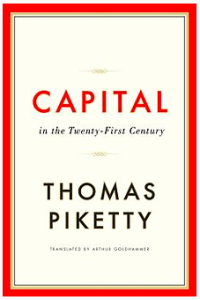 1. “Capital in the 21st Century,” by Thomas Piketty, 626 pages, Harvard University Press, April 2014
1. “Capital in the 21st Century,” by Thomas Piketty, 626 pages, Harvard University Press, April 2014
French economist Thomas Piketty’s “Capital in the 21st Century” is the book that most set pulses racing in 2014. The nearly 700-page book sold 80,000 copies in two months and appeared on at least 10 lists of the year’s best business books, including those of The Economist, the Washington Post and Kirkus Reviews. The Financial Times named it the Business Book of the Year, a title that comes with a £30,000 prize, despite having some quibbles with the way Piketty crunched his data. In the New York Review of Books, Paul Krugman called the book a “magnificent, sweeping meditation on inequality,” and gave Piketty credit for mainstreaming the idea that we have embarked upon a second Gilded Age.
Piketty’s work, which was translated from French into English last year, uses historical data to argue that the wealth gap is the widest it’s been in decades. He contends income inequality has been increasing sharply since the 1970’s, resulting in fewer opportunities for the middle and lower classes to climb the economic ladder. The book’s release coincided with a heavy focus on income inequality in the news, which chronicled the shrinking U.S. middle class, sinking deeper into debt despite the nascent economic recovery, as well as a battle over the federal minimum wage.
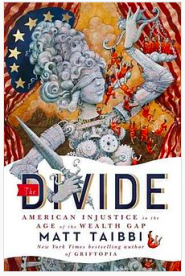 2. “The Divide: American Injustice in the Age of the Wealth Gap,” by Matt Taibbi, 416 pages, Spiegel and Grau, April 2014.
2. “The Divide: American Injustice in the Age of the Wealth Gap,” by Matt Taibbi, 416 pages, Spiegel and Grau, April 2014.
Investigative journalist and firebrand Matt Taibbi took a different approach to the subject of wealth inequality, linking it to a “justice gap,” whereby the poor are harshly prosecuted while the ultra-rich are given a pass by the courts. Taibbi’s “The Divide” was named one of the best books of the year by NPR, Kirkus Reviews and The Washington Post. In it, Taibbi writes, “every day on Wall Street, money is stolen, embezzled, burgled, and robbed. But the mechanisms of these thefts are often so arcane and idiosyncratic that they don’t fit neatly into the criminal code, which is written for the dumb crimes committed by common stick-up artists and pickpockets.” Taibbi digs into not just the crimes and lives of investment bankers, hedge fund managers and short sellers, but of small time street criminals and drifters who get caught up in the system. The New York Times writes that it is these “many deeply reported, highly compelling mini-narratives of dysfunction within the criminal justice system that make ‘The Divide: American Injustice in the Age of the Wealth Gap’ as infuriating as it is impossible to put down.”
THE FINANCIAL CRISIS
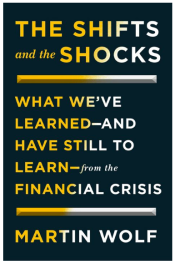 3. “The Shifts and Shocks,” by Martin Wolf, 464 pages, Penguin Group, September 2014.
3. “The Shifts and Shocks,” by Martin Wolf, 464 pages, Penguin Group, September 2014.
Journalists, politicians and economists are still trying to understand what went wrong during the 2008 economic crisis, whether we are in for another round, and if so, whether we are prepared for it. Financial Times columnist Martin Wolf’s book “The Shifts and Shocks,” consistently named one of the best books of 2014, offers a fresh look at the root causes of the crisis, with The Economist describing it as “a fierce indictment of the global economy and a call for radical reform.” Wolf points the finger at policy makers who displayed “ignorance and arrogance” in the actions taken post-crisis, including rushing into fiscal austerity and failing to adequately restructure debt. He warns that the global economy and markets are even more fragile and prone to panic than they were before. He also argues that reform should focus on creating greater macroeconomic “balance,” reducing dependence on debt and decreasing leverage in the banking system.
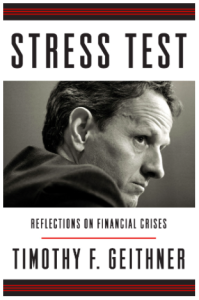 4. “Stress Test: Reflections on Financial Crises,” by Timothy Geithner, 592 pages, Crown Publishing Group, May 2014.
4. “Stress Test: Reflections on Financial Crises,” by Timothy Geithner, 592 pages, Crown Publishing Group, May 2014.
Former president of the Reserve Bank of New York and former U.S. Treasury Secretary Timothy Geithner was the focus of much criticism for the U.S. government’s response to the 2008 mortgage crisis. In his new memoir, which made the Financial Times’ best books list, Geithner offers an insider’s look at how decisions were made in the corridors of power, as well as a guide to how governments can better manage financial crises in the future. It’s also a sort of coming of age tale of his transformation from “charmingly bewildered young person to unsentimental pragmatist in a suit, who airdrops with great authority into other people’s financial catastrophes,” writes Michael Lewis in a New York Times review. In the book, Geithner defends the U.S. bailouts of big banks as well as Fannie Mae and Freddie Mac, but also shares his dislike for the “soul crushing pathologies of Washington.” He refutes claims that he was too close to Wall Street as a result of his former role at the Reserve Bank. Lewis writes that he “doubts many readers will put his book down and think the man did anything but his best.”
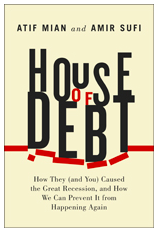 5. “House of Debt: How They (and You) Caused the Great Recession, and How We Can Prevent It from Happening Again” by Atif Mian and Amir Sufi, 192 pages, University of Chicago Press, May 2014.
5. “House of Debt: How They (and You) Caused the Great Recession, and How We Can Prevent It from Happening Again” by Atif Mian and Amir Sufi, 192 pages, University of Chicago Press, May 2014.
The authors of “House of Debt” have a very different vision of the financial crisis—and make a particularly scathing critique of former Treasury Secretary Geithner, along with the former Federal Reserve chairman, Ben Bernanke. The Financial Times contends that “House of Debt” could be the most important economics book to come out of the 2008 financial crisis, because it offers an alternative and persuasive argument about its origins. Atif Mian, an economist at Princeton University, and Amir Sufi, a finance professor at the University of Chicago, contend that economic recessions often follow surges in household debt, and that policy makers placed too much emphasis on bailing out banks rather than helping homeowners. “Evidence demonstrates that this relation is robust internationally,” the authors write. Their proposed solution is the shared mortgage, where “financial contracts more equally imposed losses on both borrowers and lenders.” The Economist suggests that Mian and Sufi’s radical ideas are unlikely to be adopted overnight, but concludes that the “admirably clear book gives us an imaginative way of addressing the problem.”
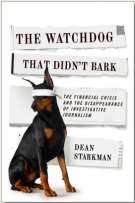 6. “The Watchdog That Didn’t Bark”, by Dean Starkman, 368 pages, Columbia University Press, January 2014.
6. “The Watchdog That Didn’t Bark”, by Dean Starkman, 368 pages, Columbia University Press, January 2014.
Journalist Dean Starkman’s “The Watchdog That Didn’t Bark” offers yet another angle on the failures of the crisis with his examination of the role played by the U.S. business media. In the book, Starkman details the many ways in which the press failed in its responsibility to investigate and hold accountable Wall Street banks and major mortgage lenders in the years preceding the crisis. Kirkus Reviews calls the book “fair and balanced as a solar-plexus punch can be.” Starkman gives credit to the individuals and publications that predicted the mortgage mess, but calls them out for not doing enough to have any real impact. Starkman uses the mortgage crisis and its aftermath to highlight the plight of the news business. The rise of the Internet, he notes, has stripped newspapers not just of revenue but of time for true investigative reporting.
TECHNOLOGY AND MARKETS
 7. “Flash Boys: A Wall Street Revolt”, by Michael Lewis, 288 pages, W.W. Norton & Company, March 2014.
7. “Flash Boys: A Wall Street Revolt”, by Michael Lewis, 288 pages, W.W. Norton & Company, March 2014.
In a bull year for U.S. stocks, Michael Lewis’ latest book, “Flash Boys: A Wall Street Revolt” shines a light into a dark corner of Wall Street: high frequency trading, split-second computer-driven trading that now accounts for 50% of stock market transactions. The practice may constitute a giant swindle of individual investors, with spoils going to the high frequency trading firms and the biggest banks. Lewis’ book made the best book lists of the Financial Times, Kirkus Reviews, and The Guardian. In his NYTimes column, Columbia Journalism School Professor Jim Stewart called the book “a welcome addition to a growing chorus calling for further investigations and reforms,” while The Wall Street Journal said it exposes “the “Pandora’s box of ridiculousness” that financial exchanges have become. Investigations into the activities of high frequency trading firms were ramped up after the publication of Lewis’ book in March, according to Reuters. In November, the U.S. Securities and Exchange Commission wrote new rules to increase regulation of high frequency trading platforms.
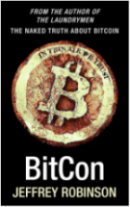 8. “BitCon: The Naked Truth About Bitcoin”, by Jeffrey Robinson, 149 pages, Amazon Digital Services, 22 September 2014.
8. “BitCon: The Naked Truth About Bitcoin”, by Jeffrey Robinson, 149 pages, Amazon Digital Services, 22 September 2014.
After a one-year investigation into bitcoin, Jeffrey Robinson concluded that the virtual currency is a just a casino chip for a loaded roulette wheel, a “pump and dump scam.” Robinson “reduces the entire phenomenon to a classic swindle,” writes The Financial Times, as he tries to unravel the misinformation that dominates bitcoin coverage in the media. 2014 was a rough year for the bitcoin, with its value sliding from around an average of about US$800 per bitcoin in January last year, to just above US$200 a year later. Meanwhile, Tokyo-based Bitcoin exchange Mt. Gox was shutdown in February, while a former Bitcoin Foundation Inc. executive, Charlie Shrem, was sent to jail for two years for charges relating to Silk Road, an illicit online marketplace for illegal drugs.
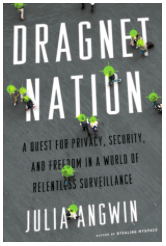 9. “Dragnet Nation: A Quest for Privacy, Security, and Freedom in a World of Relentless Surveillance”, by Julia Angwin, 204 pages, Times Books, February 2014.
9. “Dragnet Nation: A Quest for Privacy, Security, and Freedom in a World of Relentless Surveillance”, by Julia Angwin, 204 pages, Times Books, February 2014.
In her investigation into online privacy, journalist Julia Angwin made herself the guinea pig by conducting a number of experiments to see if she could protect herself from the reach of data-brokers, the government and private companies who have been using technology to sweep up large amounts of personal data. Her conclusion: there need to be new laws to make data handlers accountable to individuals. The LA Times called the book “a useful and well reported study” into the technologies and practices undergirding our culture of surveillance, while Kirkus Reviews recommended it as “a solid work for both privacy freaks and anyone seeking tips on such matters as to how to strengthen passwords.” Angwin’s work is particularly relevant in a year of cyber attacks on corporations and businesses, including Sony Pictures, E-Bay, Home Depot, Domino’s Pizza, and JP Morgan Chase, where personal information such as emails, addresses, phone numbers, credit card numbers and passwords were compromised.
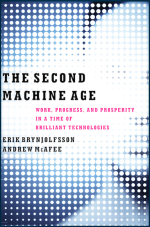 10. “The Second Machine Age: Work, Progress and Prosperity in a Time of Brilliant Technologies,” by Erik Brynjolfsson and Andrew McAfee, 320 pages, W.W. Norton & Company, January 2014.
10. “The Second Machine Age: Work, Progress and Prosperity in a Time of Brilliant Technologies,” by Erik Brynjolfsson and Andrew McAfee, 320 pages, W.W. Norton & Company, January 2014.
In “The Second Machine Age,” Erik Brynjolfsson and Andrew McAfee from MIT’s Center of Digital Business, suggest the global economy is on the cusp of a dramatic growth spurt driven by technology. But they argue that the new technology could also drive income inequality and lead to higher unemployment, if machines replace human jobs. They warn society will need to “adjust our policies, our skills, our organizations to keep up with technology.” The book was shortlisted for the Financial Times’ Business Book of the Year, and The Washington Post claims Brynjolfsson and McAfee are “pioneering a fundamental new economics, one not based on the old reality of scarcity, but on a new reality of abundance that we are only just beginning to comprehend.”
****
Minsi Chung is a freelance writer based in Stamford, Connecticut. After completing a Master’s of Arts in Business and Economics Journalism at the Columbia Graduate School of Journalism in 2013, she worked for Goldman Sachs as a video producer, and completed a Bloomberg News internship. Prior to moving to the United States, Minsi worked as an on-air television, radio, and online news journalist with the Australian Broadcasting Corporation, where she was the state business reporter in Perth, specializing in mining and resources. Before becoming a journalist, Minsi was a qualified solicitor and barrister in Western Australia. She received Bachelor of Laws from Murdoch University, and also holds a bachelor’s degree in mass communication (public relations).
This entry was posted on Wednesday, January 21st, 2015 at 3:35 pm. It is filed under Tools & Resources. You can follow any responses to this entry through the RSS 2.0 feed.
Comments are closed.
